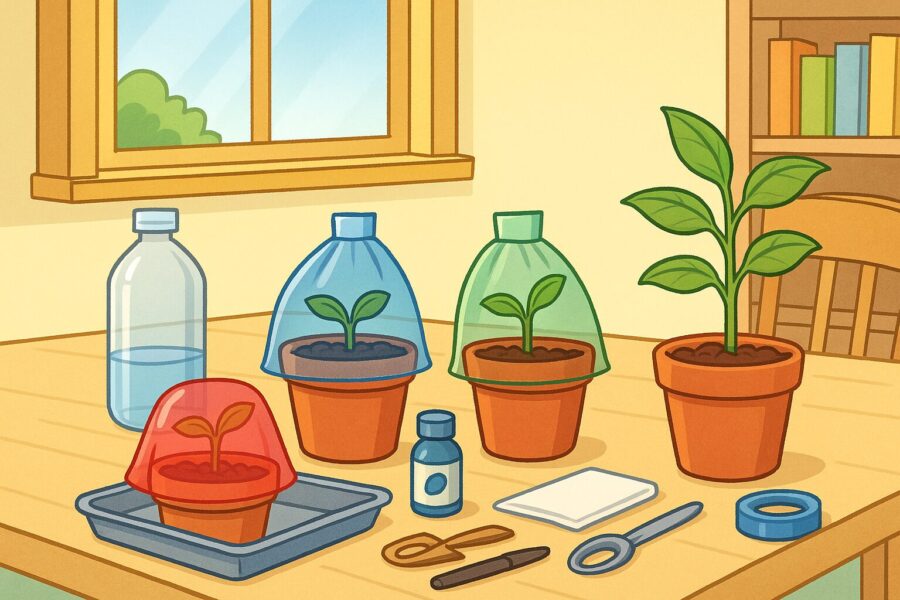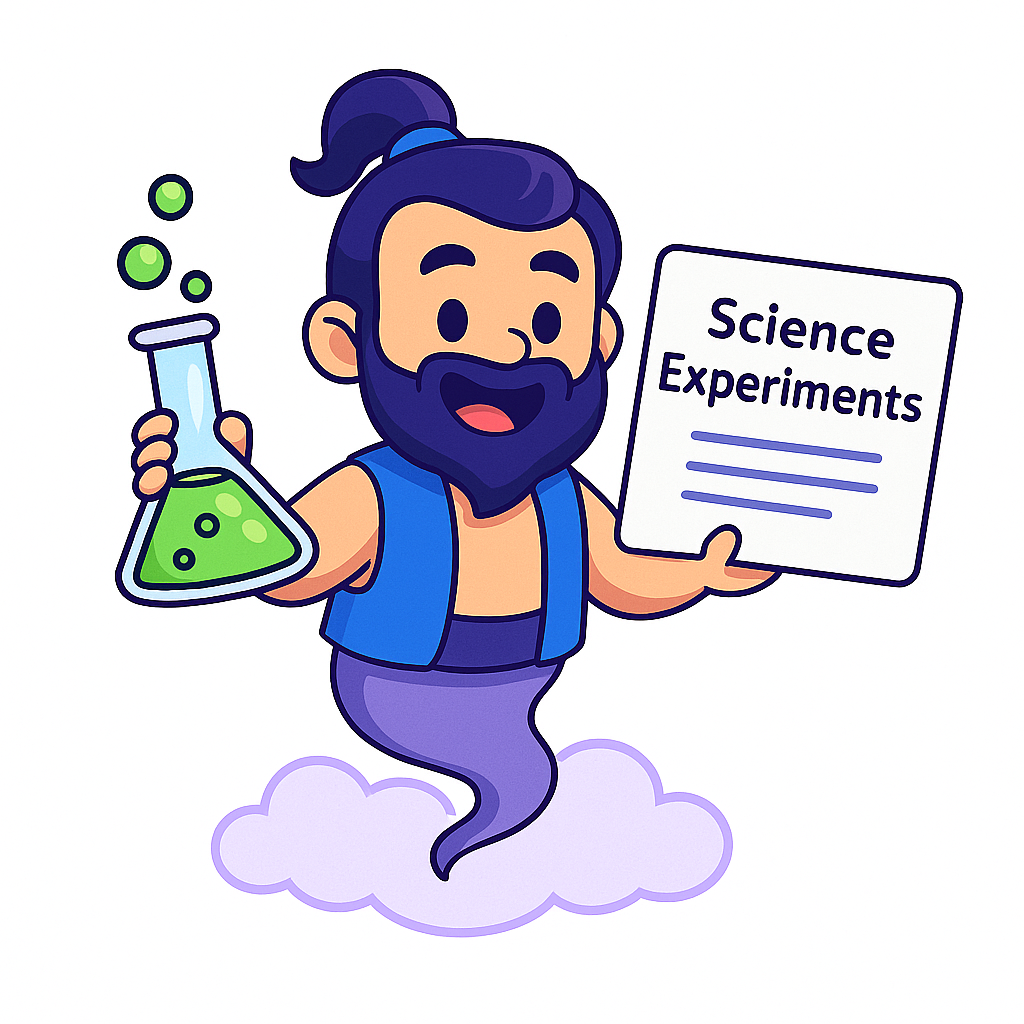 How Light Color Impacts Plant Growth:
How Light Color Impacts Plant Growth:
Colorful Science for Kids
Colorful Science for Kids
Ever wondered why plants are green, or what makes them grow strong and healthy? This experiment dives into the world of light and color—showing how red, blue, and green light each affect how well plants grow. Perfect for grades 5–8 (but fascinating for all ages), this easy home science project helps students see the science of photosynthesis in action. Parents, you’ll find full instructions, teaching tips, and real-world science explanations to make learning about plants engaging and hands-on!
Experiment Details
- Grade Level: 5th–8th Grade (adaptable for all ages)
- Key Topics: Photosynthesis, Wavelengths, Experimental Design
- Estimated Time: Setup: 20 min, Observation: 2 weeks
- Mess Factor: Low (some soil and water, easy cleanup)
Purpose: To discover how different colors of light affect the way plants grow and understand which colors help plants the most.
Hypothesis: If plants are exposed to different colors of light, then the plants under blue or red light will grow better than plants under green or no light, because plants use red and blue wavelengths more efficiently for photosynthesis.
What You’ll Need
- 4 small clear plastic cups or pots (about 4 inches tall)
- Potting soil (about 4 cups)
- Fast-growing seeds (such as radish or bean seeds), 12 seeds total
- Plastic wrap or light-proof paper
- Colored cellophane sheets: red, blue, green, and one clear
- Rubber bands or tape
- Water (about 1 cup)
- Measuring cup
- Ruler (with inches)
- Notebook and pencil for recording results

Step-by-Step Instructions
- Fill each cup with about 1 cup of potting soil, leaving about 1 inch from the top.
- Plant 3 seeds in each cup, about ½ inch deep. Cover gently with soil.
- Water each cup with ¼ cup of water, making sure the soil is evenly moist (not soggy).
- Cover the first cup with red cellophane, the second with blue, the third with green, and leave the fourth uncovered as the control.
- Secure the cellophane on each cup using rubber bands or tape, so that only colored light reaches the seeds. (Tip: You can use plastic wrap and color it with markers if you don’t have cellophane.)
- Place all cups in the same warm spot with indirect sunlight. Avoid placing near heating vents or drafts.
- Water each cup every 2 days with ¼ cup of water to keep the soil moist.
- Measure and record the height of the seedlings every other day for 2 weeks. Use your notebook to jot down changes in leaf color, size, and stem strength as well.
- Observe differences and encourage your child to sketch each plant cup for comparison.
- After 2 weeks, compare the growth, health, and color of the plants under each type of light. Which grew tallest? Which looked healthiest? Which struggled?

How Plants Use Light: Science Background for Parents
Plants need light to grow, but not all colors of light work the same way. This is because of photosynthesis, the process plants use to turn light, water, and air into food. The green pigment in plants, called chlorophyll, absorbs light best at red and blue wavelengths. That’s why grow lights and sunlight (which includes all colors) help plants thrive, but green light isn’t very effective—plants reflect it instead of absorbing it, which is why most leaves look green.
Red light helps plants grow taller and is important for flowering and fruiting.
Blue light supports strong, healthy leaves and roots.
Green light is mostly reflected and doesn’t help much with growth.
Why Do We Use a Control?
The control cup (no color) helps you compare results. If the control plant grows better or differently than the colored cups, it tells you how much the color of light matters.
Photosynthesis and Wavelengths
When light shines on a plant, chlorophyll absorbs mostly red and blue light, using the energy to turn carbon dioxide and water into sugars (food for the plant). Green light passes through or bounces off—so it doesn’t help the plant grow as much.
- Key takeaway for kids: Plants “see” light differently than we do! They need red and blue light to make food and grow healthy.
Real-World Connections
- Indoor gardeners and farmers use special grow lights that emit red and blue light for maximum plant health.
- Greenhouses use different colored covers or filters to boost plant production.
- Sunlight is best for most plants—it provides the full spectrum of light, including red and blue.
Learning Objectives
- Understand the role of light color in plant growth and health.
- Learn how photosynthesis depends on different wavelengths.
- Practice setting up and tracking a controlled experiment.
- Analyze and graph plant growth data over time.
Teaching Tips & Ideas for Parents
- Emphasize keeping all conditions the same except the color of light (same water, soil, and location).
- Encourage kids to record daily observations and draw their plants as they grow.
- Relate the experiment to sunlight and why outdoor plants thrive in full-spectrum light.
- Try the experiment with different seeds (lettuce, beans, flowers) for comparison.
- Let students predict what will happen before the experiment starts. Discuss why plants look green but don’t grow well under green light.
- Explore real-world uses: Why do greenhouses and indoor gardens use red/blue lights? How does light color impact farming and food production?
Standards Alignment
NGSS MS-LS1-6: Construct a scientific explanation based on evidence for the role of photosynthesis in the cycling of matter and flow of energy.
CCSS.ELA-LITERACY.RST.6-8.3: Follow a multistep procedure for experiments.
Printable Worksheet
Want a ready-to-use printable version for your class or homeschool?

Frequently Asked Questions
Fast-growing seeds like radish, bean, or lettuce work great. You can try flowers or herbs too—just check the germination time.
Yes! The key is to filter the light so only red, blue, or green reaches each cup. Get creative—just make sure the wrap doesn’t block all light.
Plants reflect green light instead of absorbing it. That’s why most leaves look green and why green light isn’t helpful for growth.
Use your notebook to record the height of each plant every 2 days. Make a bar graph or line graph to show how each color affected growth!
Related Experiments
- The Water Cycle in a Bag
- Homemade Compass
- Homemade Rock Candy Crystals
- See All Science Experiments & Generator
Share Your Results!
Did you try this experiment? Share your photos, results, or questions below!
⭐ What Parents & Teachers Are Saying
Recent Feedback
There are no reviews yet. Be the first one to write one.
